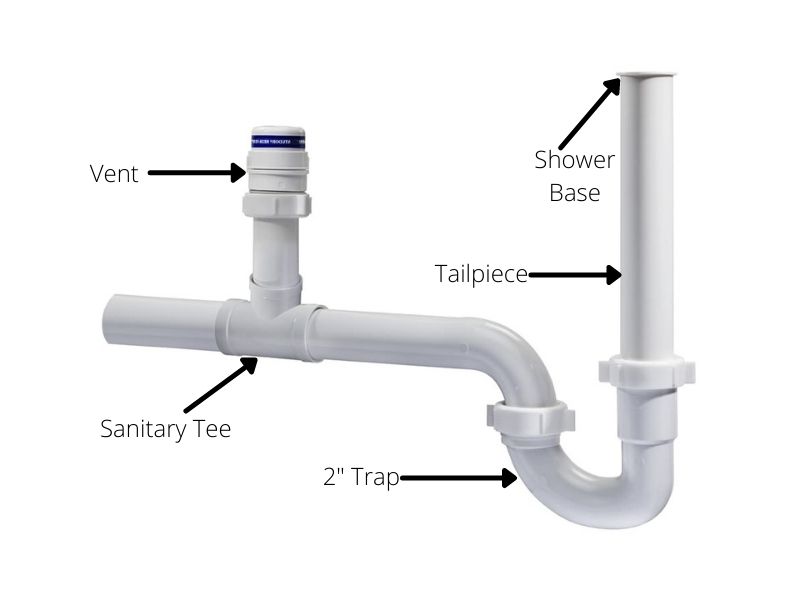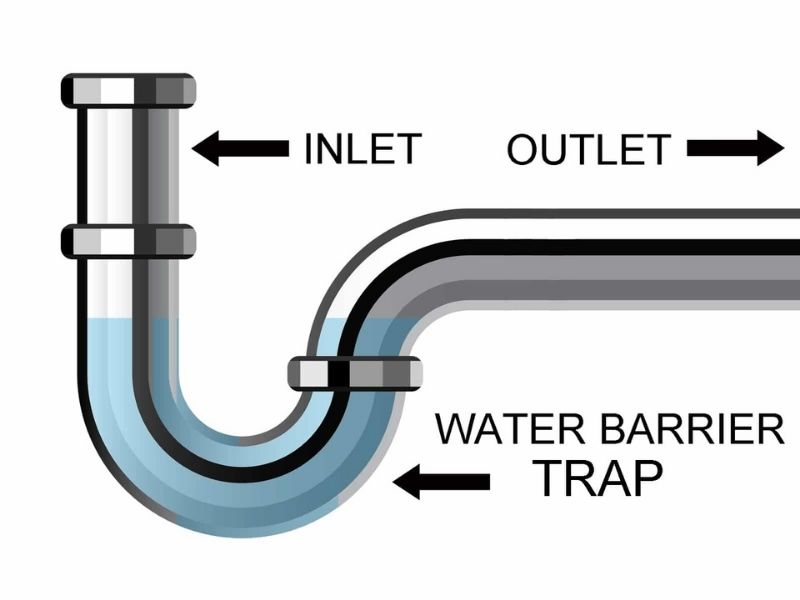A shower drain trap, also called a shower P-trap, shower U-trap, shower S-trap, shower pee trap, or simply the shower trap, is a U-shaped section of the drain pipe that keeps sewer gases from rising into your bathroom. You may not see it since it’s buried under the floor, but it’s a legal requirement for all bathrooms. If your bathroom doesn’t have it or it’s clogged, you endanger your household.
All shower drains are required by law to have P-traps. This requirement is for all household fixtures which connect to the main plumbing system. The P-trap is a curved pipe used in shower drains, sinks, and toilets to keep sewer gases and animals from entering the home through the drain pipes.
If you’ve been experiencing sewer gases or bugs in your bathroom, you likely don’t have a P-trap in your shower drain. You should enlist a plumber to check this for you and even install it if it’s missing. When I bought my current home, two of the bathrooms didn’t have traps which I had installed.

Does a shower drain need a trap?
Yes, a shower drain needs a trap. It’s also a legal requirement in the United States and many other countries. The shower pee trap helps keep sewer gases away from the shower. Given its shape and design, it also keeps animals and other items from getting into the home.
Some sewer gases, such as methane and hydrogen sulfide, are highly flammable. Others, such as carbon monoxide, reduce the amount of oxygen in the home and are poisonous, easily leading to suffocation. Without a P-trap in your shower drain, these gases will fill the home and cause damage and even death.
Each shower in the building requires its own separate P-trap to work properly. This means that even bathrooms next to each other aren’t allowed to share a P-trap.

How does a shower drain trap work?
The shower drain P-trap works similarly to the P-trap of your sink or toilet by preventing gases and objects from coming back up while allowing the same to flow down the drain.
The anatomy of a shower drain trap is made of the following parts:
1. The inlet
The inlet of your P-trap is where water enters the trap. When you shower, for example, the water goes into the drain hole on the bathroom floor, which is the inlet to the P-trap.
2. The downward bend (J-bend)
The downward bend of the P-trap assumes a ‘U’ shape or a ‘P’ shape (if the outlet is included in the shape). This part holds an amount of water which is just enough to provide an airtight seal between the sewer side and the inlet side of the P-trap. When water enters the P-trap’s inlet, it displaces the water in the trap and flows down the drain.
When sewer gases come up from the outlet side of the P-trap, they won’t pass through the water and into your home hence the ‘trap’ part of the name. It traps gases and animals that can’t go through the water and the bend to reach your home.
The downward bend has a cleanout in the middle of the ‘U’ section of the trap and is used to drain the water in the P-trap during cleaning or repair.
3. The outlet
The outlet of the P-trap is where water exits the trap and goes into the sewer line to be transported into the main sewer.
The shape of the shower drain trap often determines the name given to it. The P-trap has a ‘P’ shape, as described above. While the U-trap is just another name for a P-trap, the S-trap has an ‘S’ shape on a vertical plane where water flows downwards rather than sideways. All drain traps, however, work the same way as described above.
Shower drain P-trap depth
The depth of a shower drain P-trap is not standard but is determined by the size of the pipes or the fittings used. As long as the flooring material securely covers the drain trap and works fine, don’t worry about its depth.
How far can the P-trap be from the shower drain?
The maximum distance between the shower drain and the P-trap is 5 feet. However, the P-trap should be as close to the shower drain inlet as possible. You should even have the P-trap directly under the shower drain for the best results.
With P-traps, the further it is from the shower drain, the higher the chances of awful smells entering the home. Some may not even be from the sewer line, but the smell of decaying dirt in the section between the drain and the P-trap.
Shower P trap dimensions
The minimum size of a shower drain P-trap is 2 inches, the diameter of the pipe used to make the trap. This differs from other drain traps, such as the bathroom sink (1¼ inches) and the kitchen sink (1½ inches).
When you look at a shower trap diagram from the side, the trap’s size is the pipe’s thickness that curves to make the P-trap.
How does a shower drain work?
Water from the shower enters the shower drain opening on the bathroom floor and either directly enters the shower P trap or a horizontal pipe before the P-trap. Given that there is water in the drain P-trap, the incoming water displaces the water in the P-trap and leads it to the main sewer or septic tank.
If you’re wondering where the shower drain leads to, then it’s to the main sewer line. Basically, the shower drain and the toilet drain lead to the same destination; the sewer.
How to clean a shower P-trap
There are two methods to clean the shower drain as follows:
1. By removing the P-trap
Locate the position of the P-trap on the shower floor, then remove the flooring above it. Place a bucket underneath it to avoid spills, then disconnect it from the outlet pipe.
If there are any nuts and screws, undo them to free the P-trap. Soak it in a mixture of white vinegar and baking soda for 15 minutes then brush it before rinsing with clean water. Reinstall it back by connecting it to the outlet then returning the floor and drain cover.
2. By not removing the P-trap
Pour half a cup of baking soda into the shower drain, then add a cup of white vinegar. Cover the shower drain for 15 minutes, then flush it with hot water.
You should also clean the shower drain using a plumber’s snake or a drain cleaner. Avoid harsh drain cleaners which may damage the plumbing of your bathroom. Instead, go for enzyme-based drain cleaners which slowly eat away the dirt without harming your pipes.
These cleaning procedures should be carried out each time you clean the shower stall to keep the bathroom in good condition at all times.
How to install a shower drain trap
If your bathroom doesn’t have a P-trap or you need to replace the current one, you will need to install one. For new bathrooms, locate the P trap in the center of the shower and as close to the shower drain as possible. The steps to installing a shower drain trap are as follows:
1. Cut the subfloor around the drain
Use an electric saw to cut the subfloor around your bathroom drain to 12 by 12 inches. The section cut should be above the floorboards to allow you to nail back the subfloor when you’re done. Don’t cut too deeply to avoid damaging the floor and the drain pipes.
2. Create space around the drain
Use a pry bar to open up the floor under the square cutout. If replacing the P-trap, cut the drain pipe right after the old P-trap. If you’re installing it, cut the drain pipe the same distance from the drain as the size of the P-trap. Basically, measure the length of the P-trap from one end of the ‘U’ shape to the other, then use the same distance between the drain and where you cut the drain pipe.
3. Connect the P-trap to the drain pipe
Connect the P-trap to the horizontal section of the drain pipe using a connector and glue. Ensure the other end of the P-trap faces upwards and is directly under the shower drain.
4. Reinstall the floor
Put back the square subfloor cutout into the floor then measure the distance between the subfloor and the P-trap. Cut a pipe with this length and the same diameter as the end of the P-trap. Reattach the shower drain and the drain cover.
After an hour (for the glue to dry up), you can use your shower as usual.
What are vent pipes?
Vent pipes are pipes connected to the sewer line in the home where gases from the sewer escape to the air rather than entering the home.
Vent pipes work hand in hand with P-traps to keep sewer gases away from the house. The P-traps in toilets, sinks, and shower drains prevent the gases from returning to the house, while the vent pipes allow the gases to escape to the air outdoors. This also balances the air pressure within the pipes.
Shower trap problems and fixes
P-trap failure can occur when the trap doesn’t perform its functions. Some of the common shower drain P-trap problems include the following:
1. Clogging
Solid items, calcium build up and others may cause clogs in the shower drain. You should unclog the drain with a plunger or pour a cup of baking soda in it followed by 2 cups of white vinegar. Rinse with hot water afterward.
A plumber’s snake is also great at unclogging a shower drain P-trap. Enzyme-based drain cleaners can also be used to unclog the shower drain.
Prevent clogs in the shower drain by installing a drain cover that keeps larger objects and dirt from entering and clogging the drain.
2. Drying up
A P-trap is only good when it has water in it. When you don’t use the bathroom for long such that the water in the P-trap evaporates, sewer gases will find their way into the house leading to an unpleasant experience.
Make sure you pour water into the shower drain at least once every week to maintain the airtight seal.
Another cause for a dry shower drain P-trap is a leak. For this one, replace or repair it with glue meant for pipes.
Frequently Asked Questions
Do you need a trap under a shower drain?
Whether you have a standing shower or a bathtub, both will invariably be equipped with a p-trap. The p-trap for showers is situated beneath the fixture. Like other plumbing elements, the p-trap in the shower drain is crucial to preventing unpleasant sewer odors from permeating your pipes.
Is a drain trap necessary?
Adherence to plumbing regulations: P-traps must be installed in locations where an exposed drain line releases wastewater into a drain waste vent system. Blockage prevention: P-traps are vital in capturing solid debris that could obstruct the drain or sewer line.
What happens when you don’t install a P trap?
Inadequately installed p-traps may sustain damage, leading to the release of noxious sewer odors within your residence. The following are prevalent issues associated with p-traps: Dry p-traps occur when the trap or interceptor loses its water seal, enabling the accumulation of sewer gasses back through the drain and into your home.
